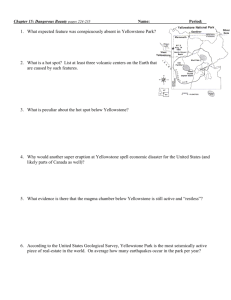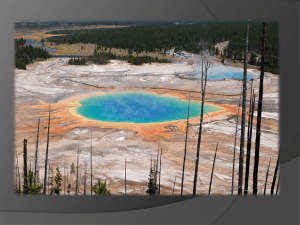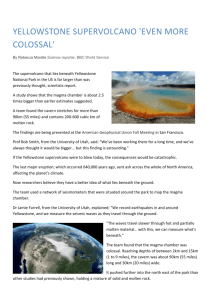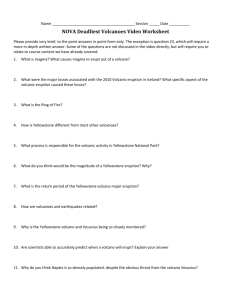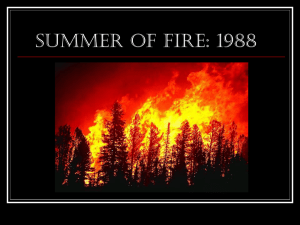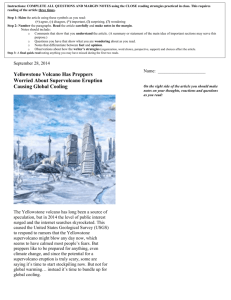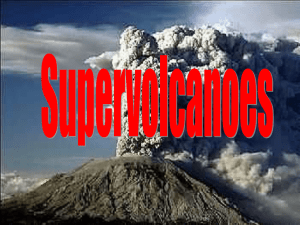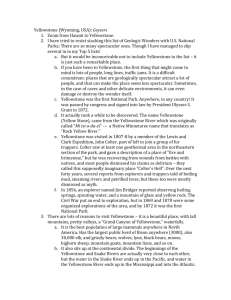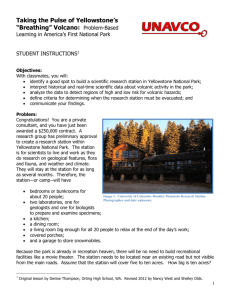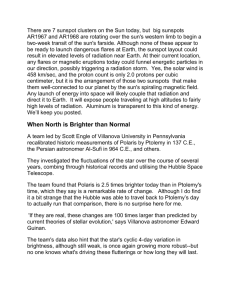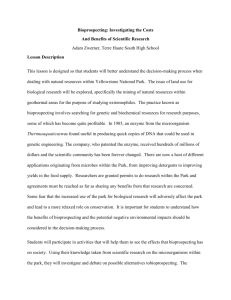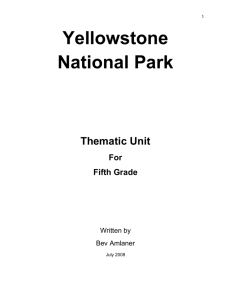File
advertisement
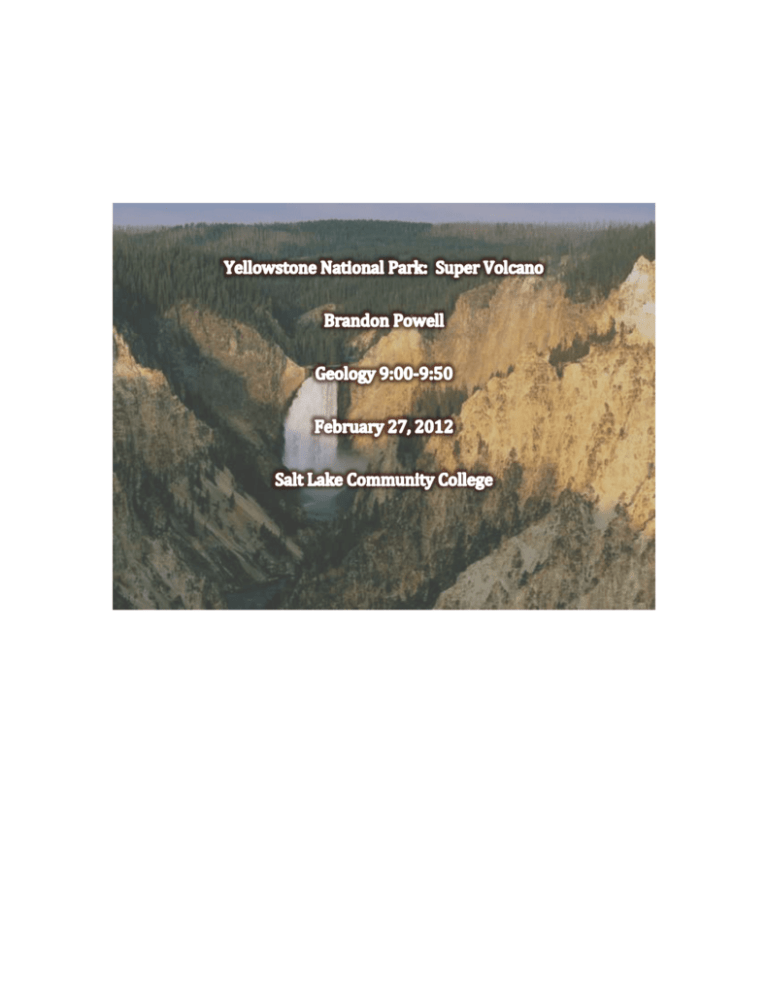
Yellowstone National Park is America’s first National Park; Ulysses S. Grant signed a law in 1872 stating it would be dedicated, and set apart as a public park or pleasuring ground for the benefit and enjoyment of the people. It is located in three different states: Wyoming, Montana, and Idaho. It is the largest National park in the lower 48 states encompassing about 2,221,776 acres. Located on the continental divide in the Rocky Mountains, the national park sits at 8,000 feet above sea level. This is a popular spot for many people around the globe, with more than 3,000,000 visitors every year. (Griffith, Carr, 2012) Long before any tourist had stepped foot in Yellowstone National Park, this super volcano erupted, and sent massive amounts of lava, ash, and debris into the atmosphere. This covered all the Western States, much of the Mid-West and Northern Mexico, and some of the Eastern States. The well-known “Old Faithful” geyser in Yellowstone National Park is proof that this super volcano is still active and will one day erupt. This is the most famous and celebrated geyser in the world, and erupts an average of Old Faithful Geyser seventeen times per day. The eruptions last between 1.5-5 minutes, and it reaches heights between 110-185 feet. It was named “Old Faithful” from its frequent and predictable eruptions. For example, if it erupted for less than four minutes the next eruption would happen 40-60 minutes later; if it erupted for more than four minutes, it would be between 60-100 minutes later. (Uhler, 1995) Geysers have water circulating deep in the earth’s crust. Water temperatures can exceed 200°F from the magma below; as the water boils the steam rises closer to the narrow passages that connect to the surface. As the water gets hotter, and boils faster the bubbles flowing through the passages get to large to pass freely, when this occurs the bubbles lift the water above, causing the geyser to splash. With the escape of some water the geyser loses pressure, which causes violent boiling. An immense amount of steam forces water out, causing the eruption. Once it begins to erupt the heat and pressure slowly decrease. It will stop when the water reservoir is empty, or the gas bubbles can escape without lifting the water. (Good, Pierce, 1998) Yellowstone is a Caldera volcano, which are the most dangerous, and have very violent eruptions. These volcanoes do not look like the usual ‘mountain shape’ volcano because of what is going on underground. Under the surface, there is Caldera volcano depression a huge magma chamber that is creating an extreme amount of pressure. This pressure causes the ground to crack in circular patterns, and after powerful eruptions and the dissipation of pressure, the circular cracks cave in, leaving large depressions in the crust. (Keller, 1998) The reason this volcano formed lies deep under the crust in the mantle. Material from the mantle is rising through the upper mantle and bringing heat to the surface, which is called a ‘hot spot’. This hot spot raises right along the North American Plate, this plate is moving about 1.8 inches per year in a southwest direction, and as it moves, the material from the mantle accumulates, and sits under the crust. The heat from the magma is melting the surrounding crust causing more and more magma to accumulate. The crust is rich in feldspar and silica, when it melts it contaminates the magma-forming felsic rich magma. Felsic rich magma causes the most dangerous, and explosive eruptions. This hot spot has been interacting with the North American Plate for nearly 17 million years, and there have been some catastrophic eruptions. The Yellowstone super volcano has erupted three times in its lifetime. Read in National Geographic, the most recent eruption happened about 640,000 years ago, with power a thousand times stronger than Mount St. Helens in 1980, this super explosion is estimated to have shot ash and debris 100,000 feet in the air. This buried much of the Western United States, and down to the Gulf of Mexico. The Dense pyroclastic flow was superheated to 1400° F, and destroyed everything in it’s path. The dense, hot material cooled over the landscape; leaving nothing but hardened lava for miles. Yellowstone Lake sits in the depression made from this eruption, and is the largest Alpine lake in the world. The largest eruption happened about 2.1 million years ago. It was the largest volcanic explosion in history, more Yellowstone Lake than doubling the intensity and strength of the eruption 640,000 years ago. This explosion sent over 600 cubic miles of rock and ash into the atmosphere, gas mixing with water vapor created sulfate aerosols, dimming sunlight and drastically changing the climate around the world. This explosion buried much of the United States in ash, the Western US ranged from 4-10 feet, and there were inches found all the way to the east coast. With all the magma and pressure that escaped, the ground caved in leaving a depression 50 miles long, and 40 miles wide. This eruption killed off much of the human population- it is estimated it reduced to the thousands. The smallest eruption coming from Yellowstone National Park happened about 1.3 million years ago. Although it is the smallest, it exploded with catastrophic results. (Achenbach, 2009) This brings a question to mind, “When’s the next time it’ll erupt?” Predictions have been made it could happen in the near future, since 2004 the ground has been rising at an unusual rate. In the past three years alone it has raised nine inches. In an article it reads: if this massive super-volcano exploded, it would erupt with power a thousand times stronger than Mt. St. Helens in 1980. Lava would be pouring out, and ash would fan out and bury everything with ten feet of ash up to 1,000 miles away. Two-thirds of the US would be inhabitable from the toxic air, millions of American’s would have no choice but to leave their homes, and air traffic could be down for an extensive period of time. However, scientists are unable to put a date on when this could happen, and since the magma is nearly 6.5 miles below the surface, it brings more peace to mind. They are unsure how full this cauldron will get before it erupts, it could be in the near future-or centuries away. (Bates, 2011) At a depth of about four hundred miles sits the ‘hot spot,’ which rises to about 30 miles before spreading out to a width of three hundred miles. This is where the volcano sits, waiting to explode. Since the conditions are so extreme, it is hard to fully understand what is happening at these depths, but scientist think the ground is rising due to the increase of magma 6.5 miles below the surface. Yellowstone is a massive volcano, and if it erupted in this day and age it would come with catastrophic consequences. Even though scientists are unable to put a date on when this explosion will take place, we do know it brings millions of tourists every year, and is a place that many people enjoy… for now. References Achenbach, J. “Will Yellowstone Blow Again?” National Geographic. 216 (2): 56-57 (2009) Bates, D. “Could Yellowstone National Park’s caldera super-volcano be close to eruption?” Mail Online. (2011) Blanton, D. “Yellowstone National Park”. U.S. National Park Service Website. Geology field notes. (2011) Dzurisin, Christiansen, and Pierce. “VOLCANO HAZARDS FACT SHEET”. Yellowstone: Restless Volcanic Giant. (1995) Good, J. and Pierce, K. “Geysers”. Geology of Grand Teton & Yellowstone National Park. (1998) Griffith,C and Carr, F. “National Park Conservation Association”. Protecting our parks. (2012) Keller, E. “Caldera Volcanoes”. Extreme Science. (1998) Uhler, J. “The Total Yellowstone Page”. Old Faithful Changes – Naturally and Constantly. (1995) Ward, D. “An overview of Yellowstone Geologic History”. Thermal Biology Institute (TBI). (2006)
